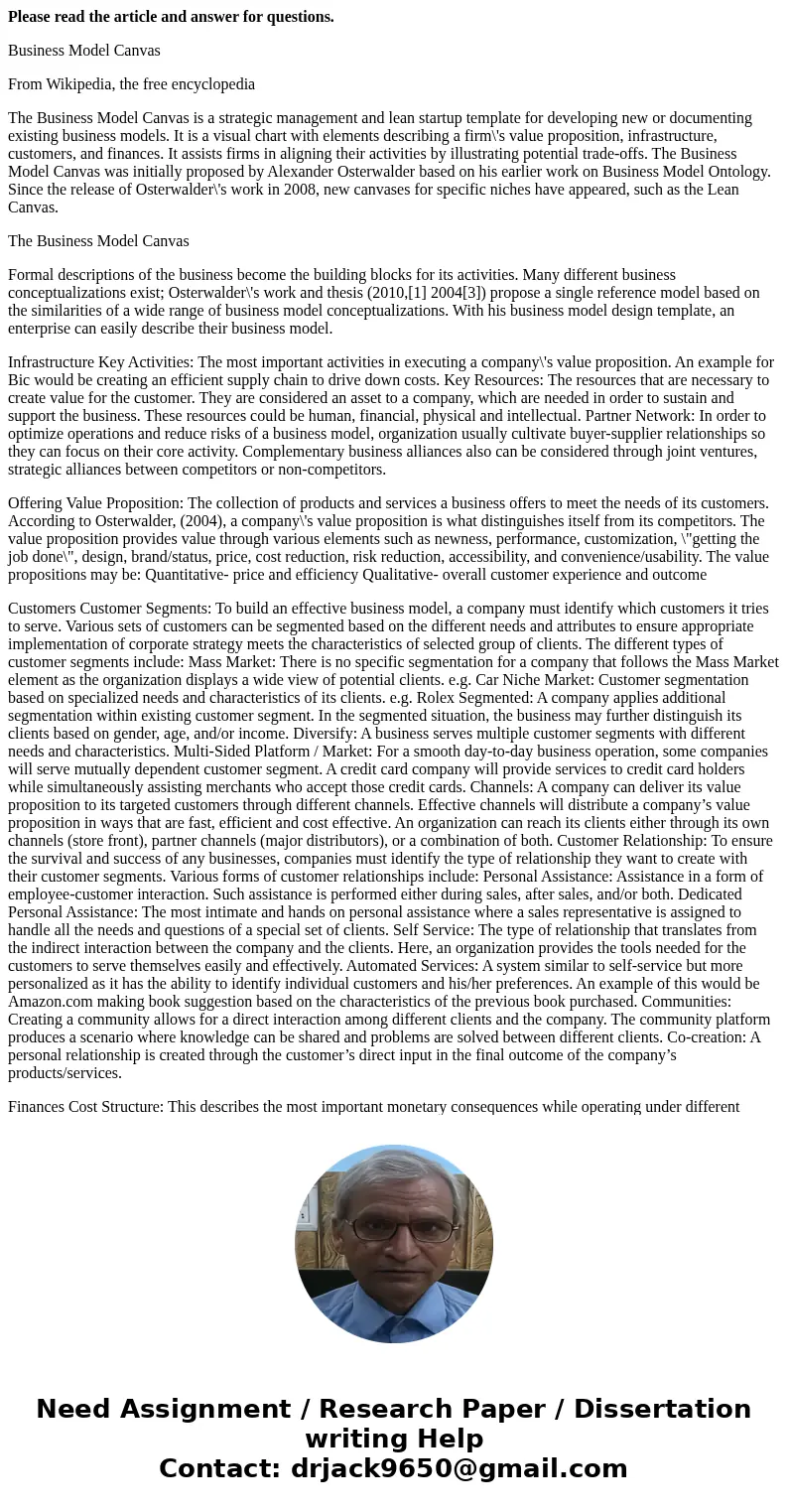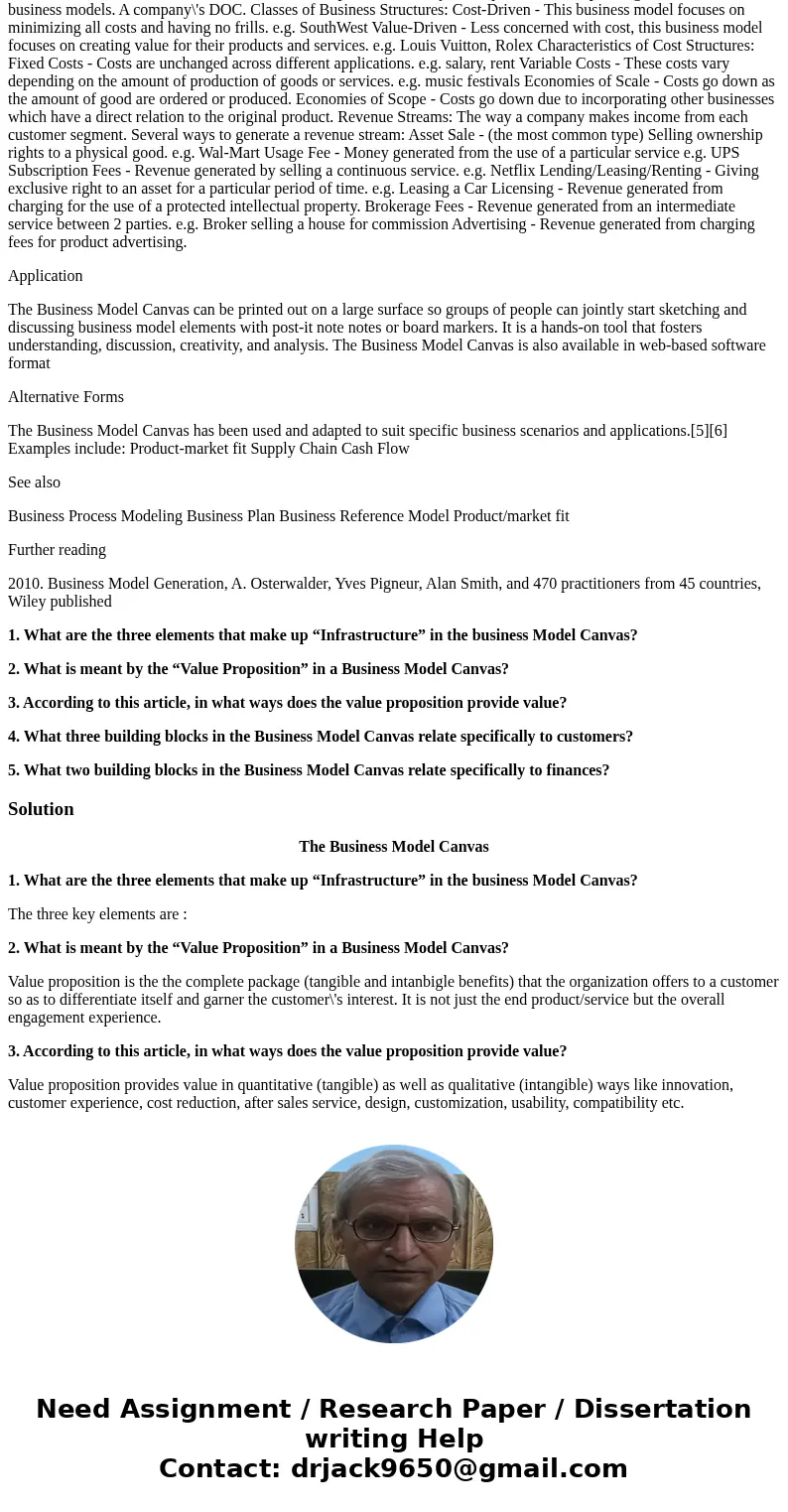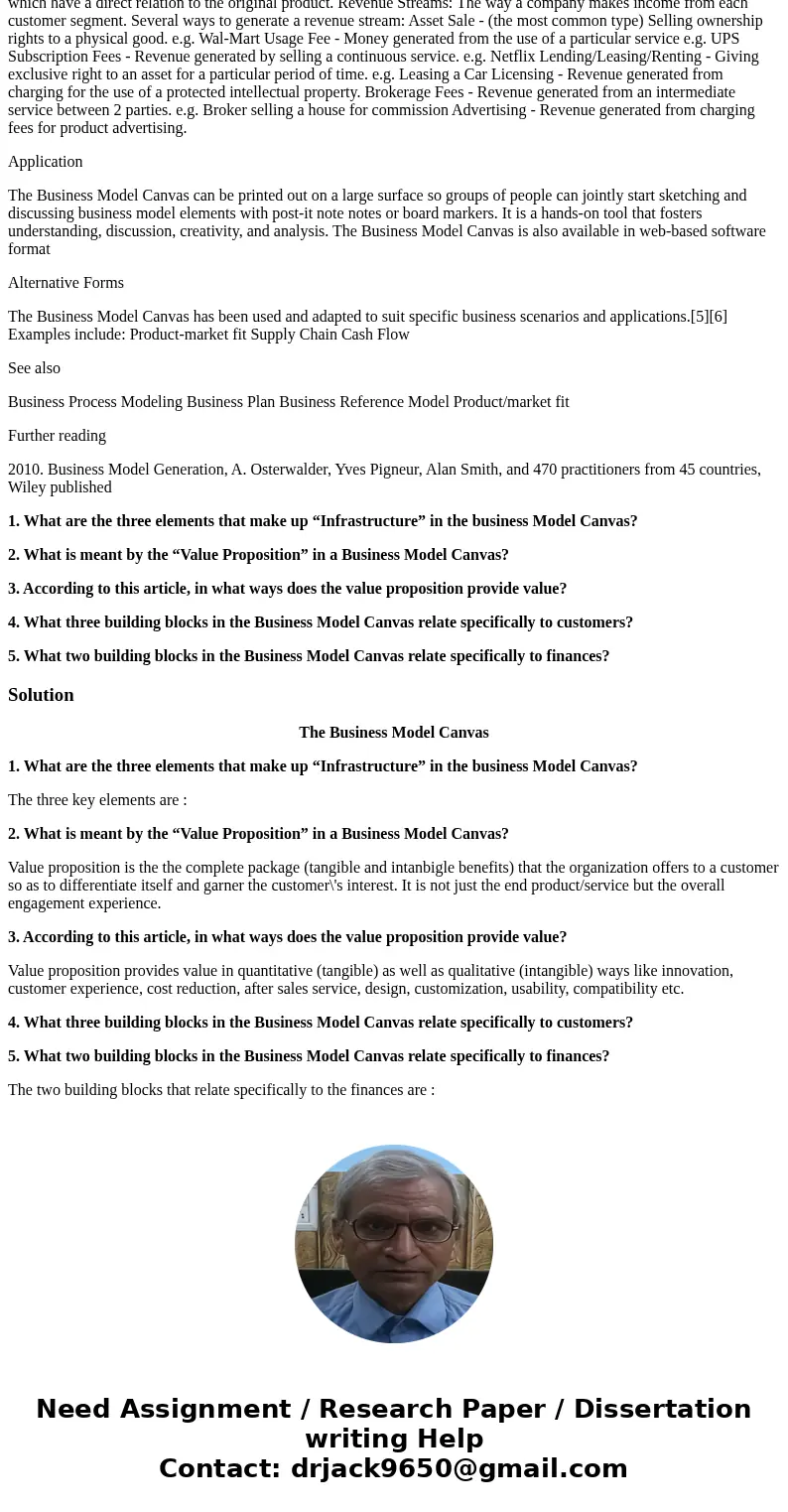Please read the article and answer for questions Business Mo
Please read the article and answer for questions.
Business Model Canvas
From Wikipedia, the free encyclopedia
The Business Model Canvas is a strategic management and lean startup template for developing new or documenting existing business models. It is a visual chart with elements describing a firm\'s value proposition, infrastructure, customers, and finances. It assists firms in aligning their activities by illustrating potential trade-offs. The Business Model Canvas was initially proposed by Alexander Osterwalder based on his earlier work on Business Model Ontology. Since the release of Osterwalder\'s work in 2008, new canvases for specific niches have appeared, such as the Lean Canvas.
The Business Model Canvas
Formal descriptions of the business become the building blocks for its activities. Many different business conceptualizations exist; Osterwalder\'s work and thesis (2010,[1] 2004[3]) propose a single reference model based on the similarities of a wide range of business model conceptualizations. With his business model design template, an enterprise can easily describe their business model.
Infrastructure Key Activities: The most important activities in executing a company\'s value proposition. An example for Bic would be creating an efficient supply chain to drive down costs. Key Resources: The resources that are necessary to create value for the customer. They are considered an asset to a company, which are needed in order to sustain and support the business. These resources could be human, financial, physical and intellectual. Partner Network: In order to optimize operations and reduce risks of a business model, organization usually cultivate buyer-supplier relationships so they can focus on their core activity. Complementary business alliances also can be considered through joint ventures, strategic alliances between competitors or non-competitors.
Offering Value Proposition: The collection of products and services a business offers to meet the needs of its customers. According to Osterwalder, (2004), a company\'s value proposition is what distinguishes itself from its competitors. The value proposition provides value through various elements such as newness, performance, customization, \"getting the job done\", design, brand/status, price, cost reduction, risk reduction, accessibility, and convenience/usability. The value propositions may be: Quantitative- price and efficiency Qualitative- overall customer experience and outcome
Customers Customer Segments: To build an effective business model, a company must identify which customers it tries to serve. Various sets of customers can be segmented based on the different needs and attributes to ensure appropriate implementation of corporate strategy meets the characteristics of selected group of clients. The different types of customer segments include: Mass Market: There is no specific segmentation for a company that follows the Mass Market element as the organization displays a wide view of potential clients. e.g. Car Niche Market: Customer segmentation based on specialized needs and characteristics of its clients. e.g. Rolex Segmented: A company applies additional segmentation within existing customer segment. In the segmented situation, the business may further distinguish its clients based on gender, age, and/or income. Diversify: A business serves multiple customer segments with different needs and characteristics. Multi-Sided Platform / Market: For a smooth day-to-day business operation, some companies will serve mutually dependent customer segment. A credit card company will provide services to credit card holders while simultaneously assisting merchants who accept those credit cards. Channels: A company can deliver its value proposition to its targeted customers through different channels. Effective channels will distribute a company’s value proposition in ways that are fast, efficient and cost effective. An organization can reach its clients either through its own channels (store front), partner channels (major distributors), or a combination of both. Customer Relationship: To ensure the survival and success of any businesses, companies must identify the type of relationship they want to create with their customer segments. Various forms of customer relationships include: Personal Assistance: Assistance in a form of employee-customer interaction. Such assistance is performed either during sales, after sales, and/or both. Dedicated Personal Assistance: The most intimate and hands on personal assistance where a sales representative is assigned to handle all the needs and questions of a special set of clients. Self Service: The type of relationship that translates from the indirect interaction between the company and the clients. Here, an organization provides the tools needed for the customers to serve themselves easily and effectively. Automated Services: A system similar to self-service but more personalized as it has the ability to identify individual customers and his/her preferences. An example of this would be Amazon.com making book suggestion based on the characteristics of the previous book purchased. Communities: Creating a community allows for a direct interaction among different clients and the company. The community platform produces a scenario where knowledge can be shared and problems are solved between different clients. Co-creation: A personal relationship is created through the customer’s direct input in the final outcome of the company’s products/services.
Finances Cost Structure: This describes the most important monetary consequences while operating under different business models. A company\'s DOC. Classes of Business Structures: Cost-Driven - This business model focuses on minimizing all costs and having no frills. e.g. SouthWest Value-Driven - Less concerned with cost, this business model focuses on creating value for their products and services. e.g. Louis Vuitton, Rolex Characteristics of Cost Structures: Fixed Costs - Costs are unchanged across different applications. e.g. salary, rent Variable Costs - These costs vary depending on the amount of production of goods or services. e.g. music festivals Economies of Scale - Costs go down as the amount of good are ordered or produced. Economies of Scope - Costs go down due to incorporating other businesses which have a direct relation to the original product. Revenue Streams: The way a company makes income from each customer segment. Several ways to generate a revenue stream: Asset Sale - (the most common type) Selling ownership rights to a physical good. e.g. Wal-Mart Usage Fee - Money generated from the use of a particular service e.g. UPS Subscription Fees - Revenue generated by selling a continuous service. e.g. Netflix Lending/Leasing/Renting - Giving exclusive right to an asset for a particular period of time. e.g. Leasing a Car Licensing - Revenue generated from charging for the use of a protected intellectual property. Brokerage Fees - Revenue generated from an intermediate service between 2 parties. e.g. Broker selling a house for commission Advertising - Revenue generated from charging fees for product advertising.
Application
The Business Model Canvas can be printed out on a large surface so groups of people can jointly start sketching and discussing business model elements with post-it note notes or board markers. It is a hands-on tool that fosters understanding, discussion, creativity, and analysis. The Business Model Canvas is also available in web-based software format
Alternative Forms
The Business Model Canvas has been used and adapted to suit specific business scenarios and applications.[5][6] Examples include: Product-market fit Supply Chain Cash Flow
See also
Business Process Modeling Business Plan Business Reference Model Product/market fit
Further reading
2010. Business Model Generation, A. Osterwalder, Yves Pigneur, Alan Smith, and 470 practitioners from 45 countries, Wiley published
1. What are the three elements that make up “Infrastructure” in the business Model Canvas?
2. What is meant by the “Value Proposition” in a Business Model Canvas?
3. According to this article, in what ways does the value proposition provide value?
4. What three building blocks in the Business Model Canvas relate specifically to customers?
5. What two building blocks in the Business Model Canvas relate specifically to finances?
Solution
The Business Model Canvas
1. What are the three elements that make up “Infrastructure” in the business Model Canvas?
The three key elements are :
2. What is meant by the “Value Proposition” in a Business Model Canvas?
Value proposition is the the complete package (tangible and intanbigle benefits) that the organization offers to a customer so as to differentiate itself and garner the customer\'s interest. It is not just the end product/service but the overall engagement experience.
3. According to this article, in what ways does the value proposition provide value?
Value proposition provides value in quantitative (tangible) as well as qualitative (intangible) ways like innovation, customer experience, cost reduction, after sales service, design, customization, usability, compatibility etc.
4. What three building blocks in the Business Model Canvas relate specifically to customers?
5. What two building blocks in the Business Model Canvas relate specifically to finances?
The two building blocks that relate specifically to the finances are :



 Homework Sourse
Homework Sourse